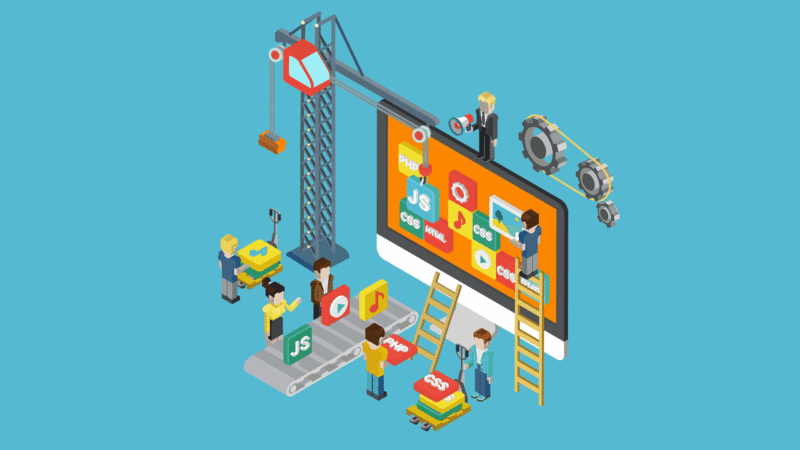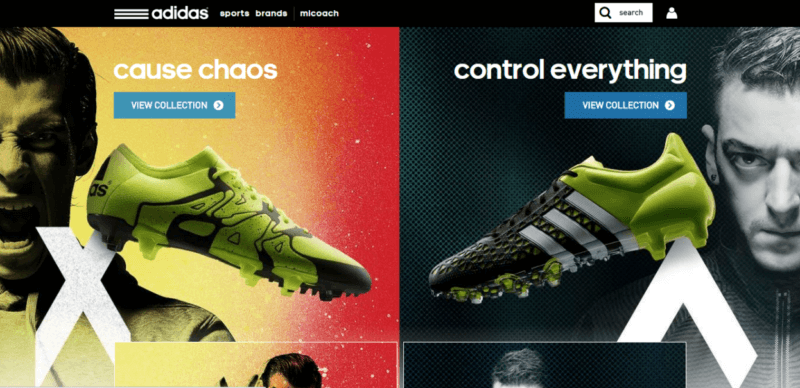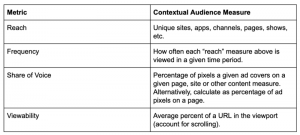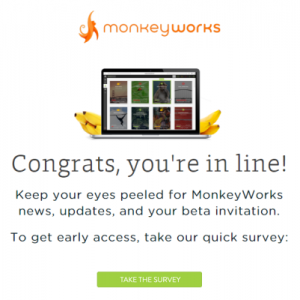Before you jump into conversion rate optimization, contributor Allen Martinez says your website must reflect a deep understanding of your customers, among other things. Read on for how best to approach the challenge.

Before I graduated from the Art Center College of Design, Lynda Weinman was my teacher for web design. Yes, THAT Lynda — who created Lynda.com and sold it for $1.5 billion to LinkedIn (just to give you some perspective on where I’m coming from).
Back then, I was fortunate enough to be around creative geniuses tackling technology in new and innovative ways, which I only later found out was not the norm. Back then, we were focused on making a website look cool and on-brand, as well as delivering relevant messaging… but in this new day and age, the X-factor for websites includes the engineering of a seamless experience to make conversions as frictionless as possible through UX (user experience) and testing. The result? A multilayered experience around product-market fit that I like to call Brand-Response.
Brand-response doesn’t stem from techy, click-baiting tactics… rather it stems from something way more primal and strategic: storytelling. This is how you can turn your branding into something original and connected while also integrating the latest tools to enhance that story experience.
Let’s be clear: There are two modes of a website’s existence:
- Launching/Testing: This is when you are finding and proving the market. This can easily take months, or longer if need be. This is the essence of your brand, your story and your tribe.
- Scaling/Maintenance: This is when you have a thriving business and are beginning to scale or are already scaling. This is the essence of your brand and your tribe plus tech plus sales enablement tools.
I find many are confused about what mode they are in. If you’re not selling out from a ton of demand, then you should not be focusing on “Conversion Rate Optimization” — not by a long shot.
If you are still finding your audience, your tribe, then you need to focus on your brand promise(s) and story. You’re still in the launching/testing phase. Some call it the MVP (minimum viable product) phase, or if you will, the “good enough… for now” phase.
Here’s a statistic:
“The ‘right [creative] message’ accounts for 80 percent of the return path,” Andrew Robertson, president and CEO of BBDO Worldwide, said at the AT&T Shape conference last year, and this figure has been confirmed by both Google North America data and Facebook data.
This means that your storytelling, your messaging, is 80 percent of the reason why your lead generation works or not… and that only leaves 20 percent for the “sales enablement” stuff that I won’t cover here since you can find a gazillon articles that already cover that. But please understand that tactical “tricks and tech” are your smallest levers for success. Below, I’ll focus on the biggest lever for success, which is storytelling.
Unless your business is already scaling out of control, getting your story right is where you’ll see the biggest gains.
Consider this scenario: You have a website that has consistent organic, paid and social traffic, with great page metrics such as time on site — but you are not capturing the most important users with the highest intent to convert. How are you able to communicate your value proposition while instilling trust which will lead to a conversion? Here are some steps to consider while developing a highly targeted lead-gen website.
Understand your users
Consumer research is going to be the most important thing for your business at this stage. It is very important to create content around your user base’s needs — but you don’t know what those needs are until you do the research. This research helps you determine:
- What kind of content to create.
- How to present your message.
- What kind of language to use when writing for your audience.
- How to use imagery that resonates with your users.
Your message, as well as the language and imagery that you use, will be some of the most important details you can determine from the start. Learn how your audience connects on an emotional level to make them feel the need to buy your product or service. For example, if your audience connects to a product by feeling lucky to be part of an exclusive group, you’ll want to choose language and imagery that highlights exclusivity.
Consider how the consumer moves through your content. For example, my agency, Noble Digital, builds content based on the See, Think, Do, Care framework. I will use videos to demonstrate my point about content flow, since it’s more fun to watch than read web copy, plus it’s a good reminder of the fact that your website can and should be using video whenever possible.
SEE
The first step in the consumer journey is seeing entertaining/inspiring content. For example, the video below is for people who want to be inspired by visual imagery. They don’t want to buy anything, they just want to dream about what they could be. Your CFO may not see any point in spending money on this type of content, but consider this type of content to be a primer. It gets people looking at your brand, gives them a reason to start to care and funnels them to the next step. This type of content is usually more effective when distributed off your website, with links leading them to your website to learn more.
THINK
The next type of content is for people who want to learn something. For the video below, the audience consists of people who play soccer and also want to play a better game, help their team win or find the right products to help them enhance their game. This type of content sets you up as a company that wants to help, and it can be used both on and off your site.
Or you could blend the education with the entertainmen — a bit of See and Think at same time, such as in this video:
DO
This type of video is meant to inspire action. This one is for people who play soccer and know they need new shoes to play at their best. These people have been convinced of this need and want to make a purchase right now. This can be a separate video, or it can be a part of other videos.
Consider something like Think and Do at the same time. This type of video teaches them something and gives them a challenge:
Nothing super techy here, right? Just basic logic flow, moving users through a decision tree: If they click on this, then you will serve them that. If people click on the “shop predator” overlay, then you’ll pixel them for retargeting, and you’ll probably give them a new journey, while the others might need to see this a few more times.
See and Think should be prioritized over Do. The Do is merely the result of See and Think. If you push “Do” too hard, you are just a direct marketer/salesman with no creativity, style or grace. There is no need for direct marketing once they are on your site! When they are on your site, it’s time to entertain your audience and tell your story. So tell it well!
By the way, video is one of the best tools you have to do engage your audience, and yet it is so underutilized, or not done as well as it could be. Video will do a few things for your website presence:
- Entertain, educate and create an emotion in the user.
- Speed up the sales cycle (for B2B and complex services, video is indispensable).
- Increase time on page, which may have the added value of signaling to search engines that you’re meeting searchers’ needs (if they came to you via search).
- Increase retention and brand recall (Can you remember the subject line of the last AdWords ad you clicked on? Thought not.)
Customer Care comes after a conversion, when a user has ascended to being a potential evangelist of your brand.
Your understanding of how your customer gets to the point of relating to, learning from, using, then praising the virtues of your brand will inform all the content you need to create. Once you understand the role your site can play, you can add consistent touch points via content — white papers, videos, blog posts, infographics and so on — that are decided upon and created based on your knowledge of how and where to best target the audience.
But in order to do all that? You need to get to the research. Talk to your consumers via focus groups or surveys and understand what they need to feel connected to your product or service.
Creating credibility
To keep leads coming back to your site, it’s very important to sprinkle elements that support your brand’s credibility consistently throughout the site. Examples of social proof that ease your prospects’ minds include:
- Customer reviews.
- Reviews from professionals or industry leaders.
- A list of how your products have been featured on other websites, in other videos, on podcasts or in any media that you don’t own.
- An enumeration of the number of people who have used your services (Think of McDonald’s “number served” counter on their signs).
- Images and graphics.
The last one is undervalued but extremely important. Users are drawn to images, and being able to see a product up close, in action, will help them decide to purchase something they were on the fence about. Beautiful images are able to connect with users emotionally with instant speed, in a way that text can’t emulate. Users are more likely to get a feeling of purpose and power from a beautiful image of Nike shoes on an athlete, for example, than they are from reading a paragraph about the wonders of the brand.
Segment your users — creatively
When you hear “segment your users” you may think: back-end… data buckets, code… Tech! Ugh!
Well, when you do this “mechanically” using questionnaires, forced pop-ups, page takeovers, or drop-downs, then yeah, I can see why your eyes are glazing over. I just want to run, too!
How about doing it creatively, with visuals? I love this landing page example from Adidas.

On the “front end,” users are impassioned to choose based on their desires (not the brands’) psychologically, emotionally and visually. On the back end, they are also self-segmenting themselves to appropriate pages while producing clear data that allow the brand to later understand who is responding to what. This is a win-win.
And it’s not techy at all, is it? It’s in fact a very human way to encourage user flow. Use basic logic around “pains” and “gains” to guide your audience to what ails them or inspires them.
Notice the calls to action (CTAs) in this example have nothing to do with buying anything. They instead focus on of what the user wants to do with the shoes, or the brand promise. When you can get the user to dream (not thinking, but visualizing) and see themselves as one of these two images, then you’ve got them! This is user flow at its finest.
Map and measure out your primary and secondary KPIs
So, in the case of Adidas, the primary goal might be to segment users between product lines, first and foremost, and secondly, to drive them to a purchase. This is clearly a bigger communication strategy that goes deeper than just simply selling.
Selling is not always the best top goal. Why? Because you’ll have a hard time creating a return path once you go for the kill. Let’s face it, the average conversion rate of most websites is three to five percent. That means that 95-97 percent of the people that visit the first time will not purchase or even take any secondary actions like an opt-in, so you have to assume there has to be additional flow built into your funnel.
For most brands, you have to decide on an “experience,” like encouraging and inspiring your site visitors to identify themselves with the brand first. In a way, this is indoctrinating your customers. In the Adidas example, the user thinks, “How much chaos or control do I want in a shoe? Hmm… I never thought about that. Will they look cool on me? Will it help me perform better when I play soccer?”
Yes! You want your prospective customers to get lost in those thoughts… not “well, how much do they cost?”
Buying is often the last thing on your user’s mind unless they’ve already been to the site at least once or a few times. So think about that first-time experience. How many layers of inspirational thought can you put into your message that will also overcome sales objections?
Again, remember “brand-response,” which really means “vision-reality.” You have to balance “marketing vision” with the “sales reality” of handling sales objections, every step of the way, for different audiences that are in completely different stages of their journey.
A good website will have multiple layers of communication happening at the exact same time and can direct all that traffic the way only the most sophisticated intersection does — flawlessly.

Easier said than done, but this is the art of web design. It’s part art, part infrastructure, part goal setting.
So shoving a bright red “buy” button in front of your audience is the last thing you need to worry about. Users seldom have a hard time finding the purchase path when they’re ready to buy. So please stop wasting your time and energy focusing 80 percent of your time on that. That is not going to increase your bottom line in a meaningful way.
Rather, focus on your brand promise and the users’ gains and pains. I know… you thought this article was going to be about adding more pop-ups, analytics tools, and heavy UX blah, blah, blah? Nope! This is about story, story, story! And you have to make that story as inspiring and visually appealing as you can afford to.
Let’s say you’re not entirely sure whether your website is visually awesome or not. If you’re not quite sure, this means you definitely need to make it more visual. Trust me, when your website looks amazing and your story is flawless and inspiring, you won’t be able to stop sharing it or talking about it. It’s an awesome creation when done right.
The difference between primary and secondary KPIs
To be successful, you need to understand the difference between primary and secondary KPIs. The primary KPI should be something that the user can access on your website. This is something that they initiate after being given the opportunity to imagine themselves with your product through your story. The primary KPI should always be very easy to find, such as on the header of the website or on a sidebar.
Here are some examples of primary KPI options:
- Email sign-up form.
- Request a phone call.
- Free download of an asset (such as an educational white paper about your product).
- Purchases (of course).
Secondary KPIs, on the other hand, are things that you are measuring on the back end. These are things that you have set goals for and are keeping track of without the consumer even being aware of them.
Here are some examples of secondary KPI options:
- Watching x amount of a video.
- Increased time on site (e.g., reading multiple blog posts).
- Social shares.
- Click-through rates on advertisements.
- Sales cycle patterns between first click and purchase.
How to measure your KPIs
Having all these KPIs in place is great — unless you aren’t using them to learn more about your audience. If you’re just collecting data and not considering what it actually means, it’s useless to you.
You need to understand how your social shares help you, and if your social shares are down, you need to know why and what you can do to raise them. You need to understand why users aren’t signing up for your email newsletter and what you can do to make that more enticing.
There are some tools that can help you better analyze the data that you get from your KPIs, such as:
- Google Analytics.
- Google Analytics Event Tracking.
- Custom JavaScript to track clicks and other events.
- Heat mapping to see where your users are spending time on a page
- A social shares plugin on WordPress.
Understanding and incorporating your leads into the funnel
It is very important to understand where the lead is within the user journey. Asking for additional information on your form can be a great way of collecting data that you can later use to segment. The common form generally asks for the user’s name and email. But if you can gather more information to help segment your users right then, it will help you incorporate your leads into the right spot in the funnel.
Adding a list of checkmarks that apply to the services they may be interested in, for example, will allow you to optimize your leads and focus on those with higher intent to convert. You could also add some questions that will allow you to gather more consumer insights, such as:
- How did you hear about us? This helps you discover which of your marketing avenues are working the best.
- What is your age range? This is a common question that businesses ask, presenting a range of ages for consumers to choose from. This helps you learn more about who is seeking out your products and services.
- Ask about their level of expertise relating to your product. For example, if you sell computer equipment, present a multiple-choice question that states “I am a…” with options such as “computer hobbyist, IT service provider, business owner” and so on. This question helps you determine what type of customer is seeking you out.
It’s important to keep the number of questions low at any given time. With more data inputs comes more user friction! So don’t get data-greedy. If you put the user through too much, your dropoff rate will only rise.
Segmenting the data — MQL vs. SQL
MQL refers to “marketing qualified leads” — in other words, engaged leads. These are people that are initiating contact with you, rather than the other way around. You aren’t sure exactly how interested they are (they could just be browsing), but their actions make it very easy to determine where they are in the sales funnel.
SQL means “sales qualified lead,” and that means that the lead has already been vetted by your sales efforts as having very high interest. These are people who click on your PPC ads — you had to pay to get their attention, but because they clicked on the ad, you have a good idea that they are pretty interested in what you have to offer.
Based on the additional data supplied by a form, or by the way the user converted on the site form vs. white paper or content download, you can segment them into higher levels of leads.
And then, based on the segmentation of these levels of intent, you can initiate different strategies with the two groups.
For example, your messaging will be different for those who arrived via a click-through on an advertisement. For these SQL leads, you’ll need to focus on why they clicked your ads. Solve their problem with your product.
But with MQL leads, you don’t know what their problem is. So instead, your messaging needs to be more focused on getting them to envision themselves with your product.
Promotional offers also will be different for SQL and MQL leads. For SQL leads, when you know why they are there, you’ll want to give them promotional offers that get them to buy right then. You already know they plan to buy a product — so offer free shipping to entice them further. With an MQL lead, however, you don’t know if they intended to buy anything. You need to make them feel like they have nothing to lose, so consider a “first-time buyer” discount or something similar.
The level of your own engagement will change based on whether a lead was an SQL or an MQL. It’s very important to contact SQLs faster and more frequently, because you want to take advantage of the known interest. With MQLs, you’ll need to keep your message in front of them without overstaying your welcome.
Once you know what type of lead a user is, you can then go back and add in layers to help accelerate certain users through your sales funnel. Watch for specific behavioral patterns that signal they’re ready to talk to sales, despite not having completed the entire funnel.
I’ve helped brands that were in growth transition — meaning that the types of customers they have now are different from the customers they want to begin attracting. If that’s the case, you need to go back to your product offerings and update them, as well as rebuild your user strategy around your new business plan. Then re-brand your story, and perhaps even re-visualize it for yourself. And then, update your website around that strategy.
Testing for conversion rate optimization
So this is the final aspect of developing a website. You now have an amazing brand identity; your messaging is clear; your products and offerings are amazing; you have designed for complex offerings like B2B or SaaS platforms and you have videos to help speed up the sales cycle. Right?
I’m also assuming you already have plenty of lead traffic flow and your business is booming. You might even be in “maintenance” mode. Then, and only then, you are ready to fuss over CRO. If you do this any earlier than you should, you will be spinning your wheels and feeling like you’re getting so much done when you’re not at all. If you’re testing button colors while your brand message is all about you (instead of your users), you won’t be going anywhere for a while.
One of the most important aspects of running a lead-gen website is consistent testing — but again, only after you’ve accomplished the other objectives first. Things that are important to test for CRO include:
- Image types.
- Copy.
- Pop-up timing.
- Button color.
- CTA copy.
Remember that testing is never “finished.” Even if you have a booming business, you should always be tweaking these things to keep attracting new buyers.
Have you ever noticed that conversion rate optimization focuses on conversion rate with no mention of revenue or any actual business metrics? That’s because it involves a series of micro goals around a big goal. The complexity of optimizing your site will be tenfold if your message and product-market fit is not rock-solid. So if this is still being proven, you might not know which way is up once you starting bringing CRO into the fold. Kind of like when you start split-testing a mediocre-performing Facebook ad set.
You also need to have statistically relevant levels of traffic flowing to the pages you are testing for CRO to even make sense. The amount of traffic you need for testing to make sense will depend on the size of your business and the size of your industry — but consultants who do this for a living suggest that even small businesses in niche industries should be seeing about 1,000 visitors per month before they bother with testing.
Be sure you give yourself several months to run a respectable test if your traffic is low. But heuristic (experienced-based) analysis can go far if you set it up correctly.
Conclusion
The importance of beginning your lead-gen efforts from the point of view of a storyteller cannot be underestimated. Remember, the steps for creating the best lead-gen website are:
- Understand your users.
- Create credibility.
- Segment your users, creatively.
- Measure primary and secondary KPIs.
- Segment the data into MQL and SQL leads or conversion states.
- Testing.
All of this data that you collect is useless without the final step of testing. If you collect data on one set of copy, one type of image, one CTA, and then you never change those things and collect new data, how will you be able to tell what was truly performing well?
Maybe you thought 10,000 views a month was wildly successful — until a slight tweak earned you a million views a month! You can generate more leads than you thought possible with these steps… but the quality of execution is everything.
Opinions expressed in this article are those of the guest author and not necessarily Marketing Land. Staff authors are listed here.
Marketing Land – Internet Marketing News, Strategies & Tips
(63)
Report Post





